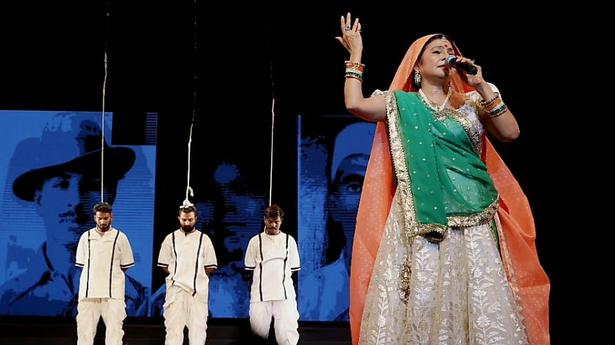
Malini Awasthi’s ‘Muktigatha’ presents songs banned by the British
The Hindu
Fourteen songs were rendered by a cast of 60 artistes led by singer Malini Awasthi
This year, more than ever, there was a surge in dance and music performances based on patriotic theme. Artistes came up with novel ways to celebrate the 75th year of Independence.
In Delhi, thumri and folk singer Malini Awasthi presented ‘Muktigatha’, using songs that were banned by the British as they connected and inspired revolutionaries across North India. After performing in Lucknow, Meerut and Kanpur, the show was recently presented in Delhi. With 14 songs rendered by a cast of 60 artistes, there was an attempt to depict all the styles of singing — kajri, hori, purbi, dadra, jhooley and ghazals. The dance forms were both classical and folk; children belonging to folk dance communities from Banda, in Uttar Pradesh, were included too, giving a more unstructured, spontaneous appeal.
“I came across a book that was printed by the Government of India in 2016. It had about 100 songs. I chose the ones that could be set to tune and were suitable for the production. Though lyrics of some songs didn’t lend themselves to singing, the raw emotion in them was inspiring,” said Malini.
The interest in these hidden gems is not new; apparently, the Government of Uttar Pradesh brought out a book titled Zaptshuda Geet in 1997 to mark the 50th year of Independence. As early as 1983, Akashvani, Gorakhpur, had aired a programme featuring some of these songs. Their lyrics cleverly intertwined the folk tradition of Holi with a growing rage and exhortation to action — ‘Hind mein kaiso phaag racho, golan ki gulal banayo, topan ki pichkaari, aisi tak tak maari.’
Several incidents related to the freedom struggle get mentioned in these songs such as Ram Prasad Bismil’s hanging in Gorakhpur jail in 1927, the attack on Lala Lajpat Rai that led to his death in Lahore in 1928, Bhagat Singh’s hanging in 1931, Chandrashekhar Azad’s trapping and death. One particularly evocative song was ‘Kitne veer jhule Bharat mein jhulanwa, jhulaye beimaan jhulawa. Veer Bismil bhi jhule, jhule Lala Lajpat Rai, jhule Chandrashekhar, jigar mein goli khaaye.’ This was presented in the tune of a ‘jhula’, with the grisly images of the hangman’s noose in the background reminding one of the grim context of the lyrics.
Some of the chirpy and inspirational songs reminded of the role of women in the freedom struggle — a beautiful ‘rasiya’ sung in Braj said ‘Preetam, chalo tumare sang, jung mein pakrungi talwar’. Malini presented Vidyadhari Bai’s Urdu composition, ‘Chun chun ke phool le lo, armaan reh na jaye, ye Hind ka bageecha, gulzar reh na jaaye’, as a ghazal. “I had first come across the song in Amrit Lal Nagar’s Ye Kothiwalliyan, a beautiful book on the lives and contributions of the bais, from Gauhar Jaan in Calcutta to Husna Bai in Benaras, to the freedom struggle.” The traditional ‘Alha’ form of storytelling was used to depict the entire mutiny.
Malini hopes to make it a pan-India presentation by including stories of revolutionaries from other regions such as Bengal and South India, using local dialects and art forms.











